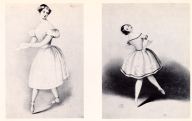 Feminine Display
Feminine Display
When he defined the appropriate and inappropriate attributes of masculinity, Janin inadvertently outlines ideal notions of femininity. The virtue of women resided, not in the masculine world of action, but in the passive display of beauty and grace. For as long as they had constituted the “fair sex”, the female form was regarded as the appropriate venue for the exhibition of beauty and splendor (Kuchta 1996). Ballerinas fulfilled this role particularly well, publicly displaying their virtues of poise, fragility and loveliness, evoking the Romantic ideals of femininity for their middle-class audience (Blanchard 1995). With the privatizing of the theatres in Paris and London at the beginning of the nineteenth century, owners and managers looked to wealthy businessmen to finance their ventures (Garafola 1985). So it was only natural, or more accurately “naturalized”, that women should take to the stage to display their skills, and themselves, to the male gaze, while the “frightful danseuse of the male sex” was exiled from the stage.